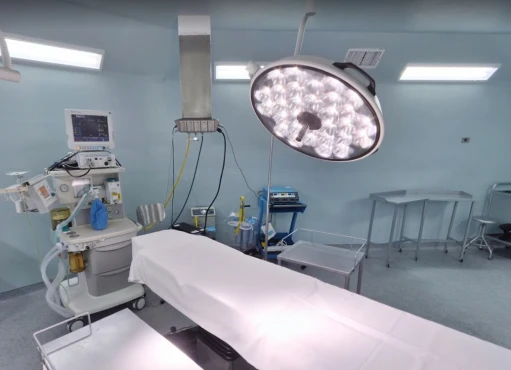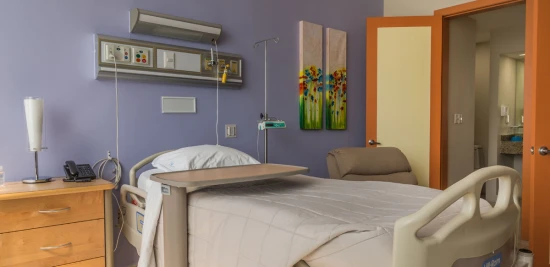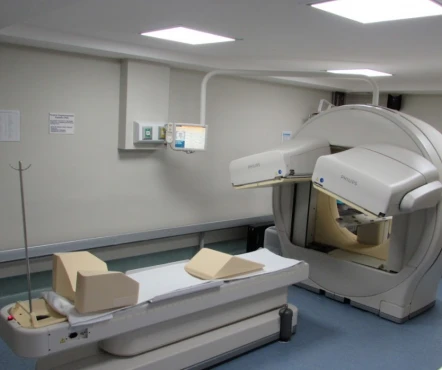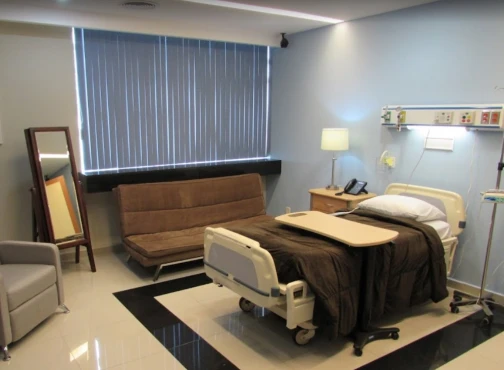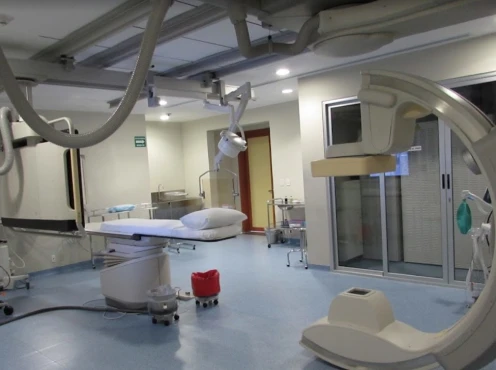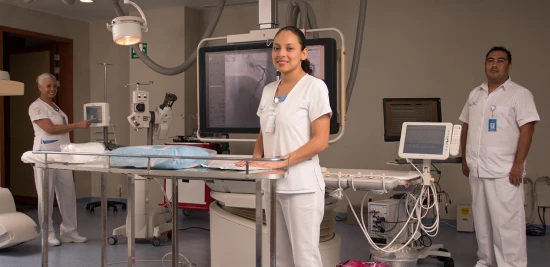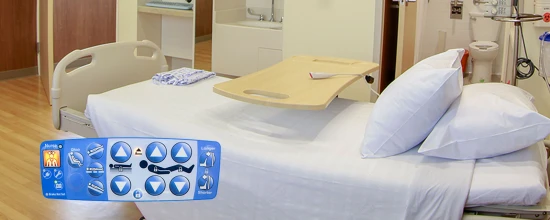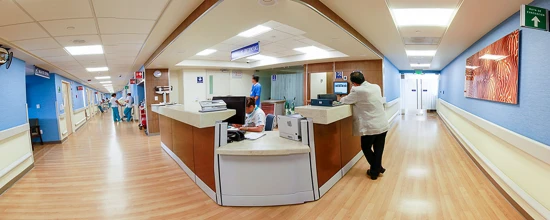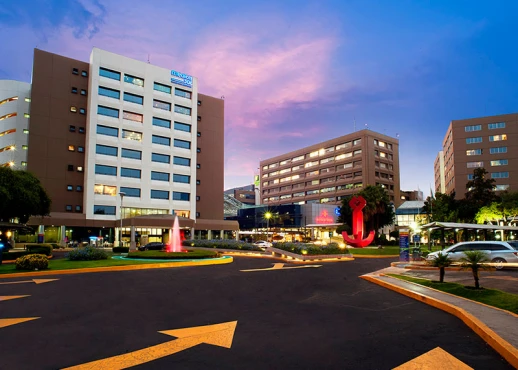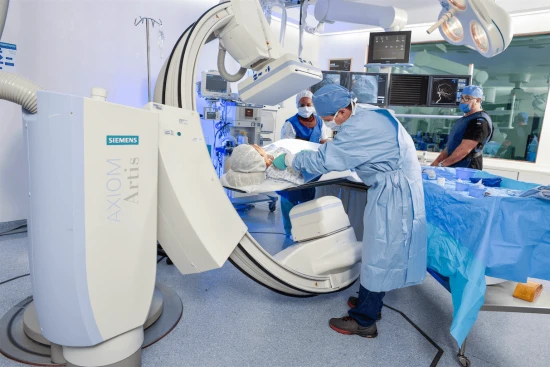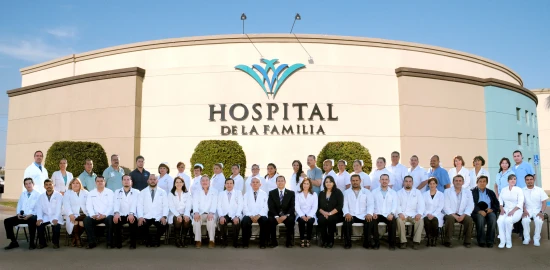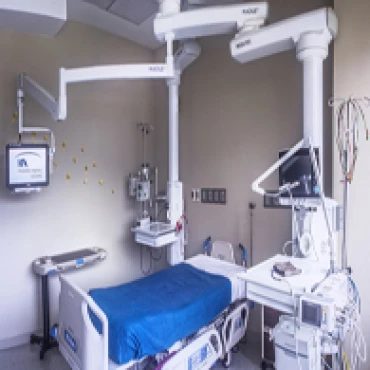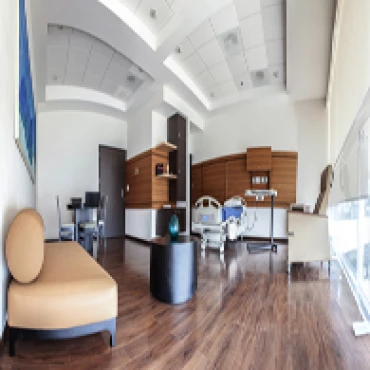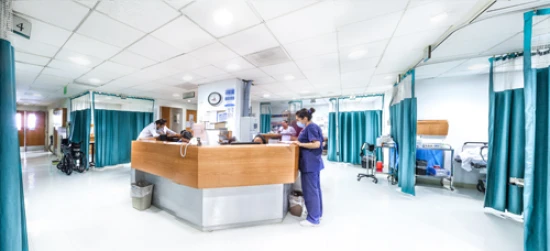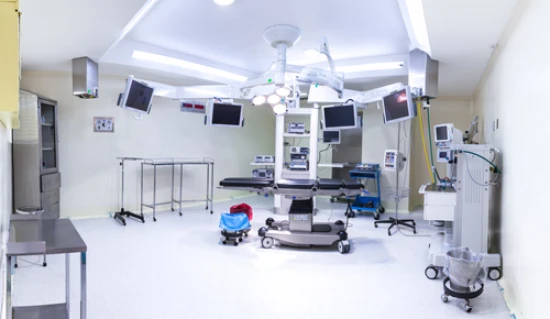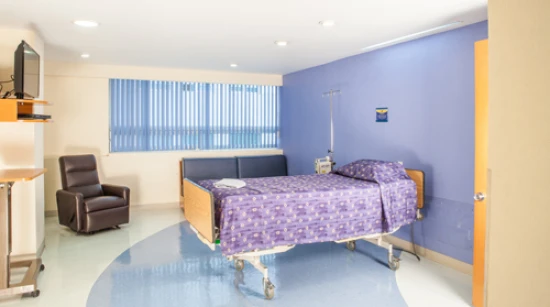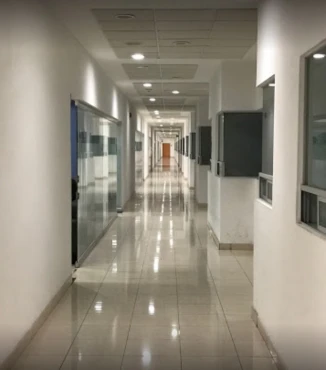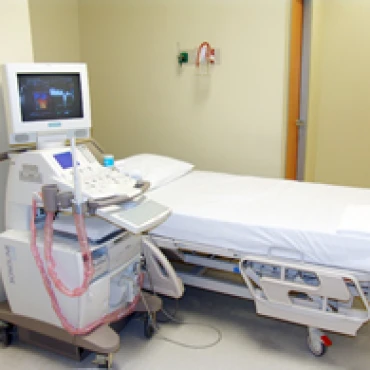Epilepsy treatment in 2 Neurosurgery and Oncology clinics in Cancún
Top
Clinics
Ratings
Diseases
More info
Quick navigation
2 clinics specializing in Neurosurgery and Oncology providing treatment of
Epilepsy
Epilepsy is a neurological disorder characterized by recurrent and unpredictable seizures. It can cause disruptions in daily life, but with proper treatment, many people can manage and control their seizures effectively.
Read more...
disease in Cancún.
1
from Mahsa Poorak
November 27, 2023
My sister was treated for kidney stones in August and we signed a document agreeing to pay $13,800. When we got home, our credit card was charged $38,000. We have made numerous attempts to speak to the hospital, no one has responded. They sent a credit card receipt that clearly shows that they forged our signature and are still demanding payment.
Stay away from this hospital, they will scam you out of lots of money.
1
from Di Mo
August 18, 2023
Terrible money scam. People were nice, but not professional. My mom had a heart issue and was sent here by Xcaret Hotel Mexico (this is a partner hospital with the hotel, says something about the hotel too). She was given EKG and blood test, which was charged 1300USD. The emergency doctor couldn't give any diagnosis with these results and wanted to refer an internal medicine doctor to continue with more procedures (for more charges). The whole time we were there there was no monitor of vital signs, the IV stopped working. We ran away without continuing with any procedure. Stay away from this hospital if you can!
5
from Suzi Brady
July 26, 2023
My son hurt his knee pretty bad after landing awkwardly trampolining at our resort. He couldn’t bare weight on it and had a lot of pain so we researched a few local hospitals and decided on Amerimed based on some of the Google reviews. We were not disappointed and so glad we picked this one. The staff were friendly, knowledgeable and got us in, x-rayed, meds and a knee brace for 6,500 pesos/ $400usd. We were out within 90 minutes.
Great experience. Thank you Amerimed.
Prices for popular procedures:
-
Deep brain stimulation (DBS)
≈ $50,350
-
Brain aneurysm repair
≈ $13,265
-
Brain aneurysm clipping
≈ $13,019
-
Microvascular decompression (MVD)
≈ $9,506
-
Arteriovenous malformation (AVM) resection
≈ $10,341
-
Brain tumors surgery
≈ $8,895
-
Peripheral nerve repair
≈ $4,041
-
Nerve decompression surgery
≈ $3,202
-
Hemicolectomy
≈ $9,736
3.1
5 reviews
1
from Mahsa Poorak
November 27, 2023
My sister was treated for kidney stones in August and we signed a document agreeing to pay $13,800. When we got home, our credit card was charged $38,000. We have made numerous attempts to speak to the hospital, no one has responded. They sent a credit card receipt that clearly shows that they forged our signature and are still demanding payment.
Stay away from this hospital, they will scam you out of lots of money.
1
from Di Mo
August 18, 2023
Terrible money scam. People were nice, but not professional. My mom had a heart issue and was sent here by Xcaret Hotel Mexico (this is a partner hospital with the hotel, says something about the hotel too). She was given EKG and blood test, which was charged 1300USD. The emergency doctor couldn't give any diagnosis with these results and wanted to refer an internal medicine doctor to continue with more procedures (for more charges). The whole time we were there there was no monitor of vital signs, the IV stopped working. We ran away without continuing with any procedure. Stay away from this hospital if you can!
5
from Suzi Brady
July 26, 2023
My son hurt his knee pretty bad after landing awkwardly trampolining at our resort. He couldn’t bare weight on it and had a lot of pain so we researched a few local hospitals and decided on Amerimed based on some of the Google reviews. We were not disappointed and so glad we picked this one. The staff were friendly, knowledgeable and got us in, x-rayed, meds and a knee brace for 6,500 pesos/ $400usd. We were out within 90 minutes.
Great experience. Thank you Amerimed.

Cancún, Mexico
Specializations: Cardiac surgery, Vascular surgery, Thoracic surgery, Neurosurgery, Spine surgery, Orthopedic surgery, Oncology
Languages: English
Amerimed® is the network of hospitals located in the main tourist destinations in Mexico, and the first organization specialized in medical tourism in the country,
read more
5
from Kim Winkler
October 18, 2023
A big thank you to the staff of Galenia hospital!!! During our stay this month, my friend became suddenly ill and had to be hospitalized. Being from the US, I must say that it was a bit nerve wracking to have to seek medical help in a foreign country. However, our experience was entirely positive!!! To the concierge staff - Eric and Alfredo - I wish to extend tremendous gratitude!!! Your translation services as well as your kindness and hospitality were both indispensable and greatly appreciated!!!! I also wish to extend my gratitude to Dr. Allejandro (I don't remember your last name); not only were you genuinely gracious, you discovered the problem quickly and got my friend back on her feet in no time at all!!! Again, thank you Hospital Galenia for such a good experience!!! You took great care of my friend and went above and beyond in showing us courtesy and consideration!!!
1
from sharon leon
March 14, 2023
BEWARE IF YOU ARE A TOURIST! My father was hospitalized on a family trip to Cancun. He was transported to this hospital and needed emergency surgery This hospital FAILED him. They wouldn’t even give him so much as saline or an antibiotic without payment in FULL. WE WERE CHARGED $4,000 FOR. He went 8 HOURS sitting on an emergency room bed when he should have been in surgery. THEY DEMANDED 50,000 DOLLARS PAID IN FULL BEFORE STARTING ANY CARE AND THAT WAS JUST FOR THE SURGERY. WE OFFERED TO PAY 25,000 SO THEY COULD START AND THEY REFUSED. WE OFFERED TO PAY THE REST THE NEXT DAY AND THEY REFUSED. WE TRANSFERRED MY FATHER TO THE OTHER HOSPITAL BECAUSE WE THOUGHT HE WAS GOING TO DIE. WE FELT USELESS WHILE THEY HAD ALL THE POWER TO DO SOMETHING THEY CHOSE TO DO NOTHING!!!!! THEY ARE SCAMMERS AND NOTHING MORE. ITS A MIRACLE MY FATHER SURVIVED AND ONLY BY THE HELP OF GOD WAS MY FATHER ABLE TO COME BACK HOME WITH US. JUST TO TOP IT OFF WHEN WE WERE PAST THE TRAUMA THAT THESE PEOPLE PUT US THROUGH THEY HAD THE AUDACITY TO BILL IS THE OXYGEN THAT WAS ADMINISTERED DURING THE AMBULANCE RIDE!! 2000 DOLLARS!!!!!!!! THEY WOULD RATHER WATCH YOUR FAMILY MEMBER DIE, I WILL NEVER FORGET THEIR DISGUSTING SMUG FACES
4
from Reina Cruz
March 09, 2023
It feels very comfortable being there. Olivia is the best. She arranges everything for you when you are from outside the country of Mexico. You show up and all is prepared. Her personality is very welcoming and friendly. I love not having to worry about the stress of paper work especially since i don't know Spanish well. All her subordinates speak English as well and are all very nice. Galenia might be costly however the peace of mind you get not being stresses out with paperwork helps a lot. I don't even need to Contact my insurance. They do everything for you. Best service. The receptionist at imaging are a bit slow and don't know any English. But the staff attending to you in the radiation area are super friendly and helpful. I see many people complain about the price. This is a private hospital and will be costly. It is the same in my own country. Private hospitals cost a lot but if you have insurance and you are not from Mexico, then I highly recommend using their tourism concierge. They are a great help and speak English. They are all very nice and helpful. I have had the pleasure of meeting and being assisted by Olivia (who is the best), Ellen, Ricardo and another guy i cant remember his name. Not sure if it is Daniel or something with a D. That was over 2 years ago i met him. They arranged everything with my insurance prior to going there. I just showed up and Olivia walked me through everything. I was in and out as quick as possible. No long waiting. Use the concierge service they have. It really helps you from stressing about paperwork and payments. My journey at Galenia started September 2021 and I continue into 2023......
Prices for popular procedures:
-
Deep brain stimulation (DBS)
≈ $50,350
-
Brain aneurysm repair
≈ $13,265
-
Brain aneurysm clipping
≈ $13,019
-
Microvascular decompression (MVD)
≈ $9,506
-
Arteriovenous malformation (AVM) resection
≈ $10,341
-
Brain tumors surgery
≈ $8,895
-
Peripheral nerve repair
≈ $4,041
-
Nerve decompression surgery
≈ $3,202
-
Hemicolectomy
≈ $9,736
3.4
5 reviews
5
from Kim Winkler
October 18, 2023
A big thank you to the staff of Galenia hospital!!! During our stay this month, my friend became suddenly ill and had to be hospitalized. Being from the US, I must say that it was a bit nerve wracking to have to seek medical help in a foreign country. However, our experience was entirely positive!!! To the concierge staff - Eric and Alfredo - I wish to extend tremendous gratitude!!! Your translation services as well as your kindness and hospitality were both indispensable and greatly appreciated!!!! I also wish to extend my gratitude to Dr. Allejandro (I don't remember your last name); not only were you genuinely gracious, you discovered the problem quickly and got my friend back on her feet in no time at all!!! Again, thank you Hospital Galenia for such a good experience!!! You took great care of my friend and went above and beyond in showing us courtesy and consideration!!!
1
from sharon leon
March 14, 2023
BEWARE IF YOU ARE A TOURIST! My father was hospitalized on a family trip to Cancun. He was transported to this hospital and needed emergency surgery This hospital FAILED him. They wouldn’t even give him so much as saline or an antibiotic without payment in FULL. WE WERE CHARGED $4,000 FOR. He went 8 HOURS sitting on an emergency room bed when he should have been in surgery. THEY DEMANDED 50,000 DOLLARS PAID IN FULL BEFORE STARTING ANY CARE AND THAT WAS JUST FOR THE SURGERY. WE OFFERED TO PAY 25,000 SO THEY COULD START AND THEY REFUSED. WE OFFERED TO PAY THE REST THE NEXT DAY AND THEY REFUSED. WE TRANSFERRED MY FATHER TO THE OTHER HOSPITAL BECAUSE WE THOUGHT HE WAS GOING TO DIE. WE FELT USELESS WHILE THEY HAD ALL THE POWER TO DO SOMETHING THEY CHOSE TO DO NOTHING!!!!! THEY ARE SCAMMERS AND NOTHING MORE. ITS A MIRACLE MY FATHER SURVIVED AND ONLY BY THE HELP OF GOD WAS MY FATHER ABLE TO COME BACK HOME WITH US. JUST TO TOP IT OFF WHEN WE WERE PAST THE TRAUMA THAT THESE PEOPLE PUT US THROUGH THEY HAD THE AUDACITY TO BILL IS THE OXYGEN THAT WAS ADMINISTERED DURING THE AMBULANCE RIDE!! 2000 DOLLARS!!!!!!!! THEY WOULD RATHER WATCH YOUR FAMILY MEMBER DIE, I WILL NEVER FORGET THEIR DISGUSTING SMUG FACES
4
from Reina Cruz
March 09, 2023
It feels very comfortable being there. Olivia is the best. She arranges everything for you when you are from outside the country of Mexico. You show up and all is prepared. Her personality is very welcoming and friendly. I love not having to worry about the stress of paper work especially since i don't know Spanish well. All her subordinates speak English as well and are all very nice. Galenia might be costly however the peace of mind you get not being stresses out with paperwork helps a lot. I don't even need to Contact my insurance. They do everything for you. Best service. The receptionist at imaging are a bit slow and don't know any English. But the staff attending to you in the radiation area are super friendly and helpful. I see many people complain about the price. This is a private hospital and will be costly. It is the same in my own country. Private hospitals cost a lot but if you have insurance and you are not from Mexico, then I highly recommend using their tourism concierge. They are a great help and speak English. They are all very nice and helpful. I have had the pleasure of meeting and being assisted by Olivia (who is the best), Ellen, Ricardo and another guy i cant remember his name. Not sure if it is Daniel or something with a D. That was over 2 years ago i met him. They arranged everything with my insurance prior to going there. I just showed up and Olivia walked me through everything. I was in and out as quick as possible. No long waiting. Use the concierge service they have. It really helps you from stressing about paperwork and payments. My journey at Galenia started September 2021 and I continue into 2023......

Cancún, Mexico
Specializations: Cardiac surgery, Vascular surgery, Thoracic surgery, Neurosurgery, Spine surgery, Orthopedic surgery, Oncology
We are the first High Specialty hospital in the Southeast of Mexico We have a state-of-the-art infrastructure with advanced medical technology and a team of
read more
Nearby clinics in Mexico
Perhaps you should consider the following clinics we have found nearby basing on your Location, Disease filters applied.
5
from Elizabeth Stillson
July 16, 2023
In 20 plus years of international travel I’ve never needed emergency services until a very bad fall in CDMX left me with 3 sprained toes, a sprained knee, a bruised hip and back and a very deflated ego. Medica Sur was AMAZING. Fastest I’ve ever been in and out of an emergency department. It felt like I had 3 dedicated doctors and never even saw the waiting room. Their English was way better than my Spanish and everything including the consultation with the trauma surgeon and X-rays was $550 total. That’s it. I’m paying more to get my teeth whitened at home.
Having damaged the same leg in similarly stupid ways before- this care was miles above what I’ve had in the past. Don’t be worried about going to the hospital in CDMX. They know what they are doing and they are super nice about everything
5
from Luis Castedo
July 11, 2023
As they advertise, best hospital in Mexico
1
from McKenna Erickson
December 31, 2022
This place's customer service sucks. I emailed them with questions regarding a minor surgery that I'm looking to get. I wanted to know what the price or approximate price would be for it, if they had availability in a certain part of the month, and if this surgery could be done at the same time.
They responded that I would need to set up a consultation in order to get the answers I was looking for. Guess how much a consultation is? USD$150 or $3300 Pesos. Seriously? I explained to them that it wouldn't make sense for me to spend that kind of money when I may find out they don't have availability for appointments when I need it. How hard is it for a hospital to tell their patients when they have appointments available?
Prices for popular procedures:
-
Gamma Knife
by request
-
Radiosurgery
$1,138 - $1,260
-
Radical prostatectomy
≈ $3,075
-
Transurethral resection of the prostate (TURP)
≈ $3,544
-
Laparoscopic cholecystectomy
≈ $1,463
-
Cholecystectomy
≈ $3,020
-
Simple mastectomy
≈ $2,929
-
Lumpectomy
≈ $984
-
Skull base surgery
≈ $12,467
4.3
5 reviews
5
from Elizabeth Stillson
July 16, 2023
In 20 plus years of international travel I’ve never needed emergency services until a very bad fall in CDMX left me with 3 sprained toes, a sprained knee, a bruised hip and back and a very deflated ego. Medica Sur was AMAZING. Fastest I’ve ever been in and out of an emergency department. It felt like I had 3 dedicated doctors and never even saw the waiting room. Their English was way better than my Spanish and everything including the consultation with the trauma surgeon and X-rays was $550 total. That’s it. I’m paying more to get my teeth whitened at home.
Having damaged the same leg in similarly stupid ways before- this care was miles above what I’ve had in the past. Don’t be worried about going to the hospital in CDMX. They know what they are doing and they are super nice about everything
5
from Luis Castedo
July 11, 2023
As they advertise, best hospital in Mexico
1
from McKenna Erickson
December 31, 2022
This place's customer service sucks. I emailed them with questions regarding a minor surgery that I'm looking to get. I wanted to know what the price or approximate price would be for it, if they had availability in a certain part of the month, and if this surgery could be done at the same time.
They responded that I would need to set up a consultation in order to get the answers I was looking for. Guess how much a consultation is? USD$150 or $3300 Pesos. Seriously? I explained to them that it wouldn't make sense for me to spend that kind of money when I may find out they don't have availability for appointments when I need it. How hard is it for a hospital to tell their patients when they have appointments available?

Mexico City, Mexico
Specializations: Cardiac surgery, Vascular surgery, Neurosurgery, Spine surgery, Orthopedic surgery, Oncology, Dentistry
Languages: English
Médica Sur S.A.B. of C.V. is a private health institution in Mexico City, which owns a hospital and 140 clinical analysis laboratory branch offices (under
read more
1
from Vee Hunnicutt
November 13, 2023
Hosp de la familia (Terror story)
Hospital de la familia :
Do not go here unless you want yo die!!
My experience at the hospital : Right as we walked In they take us into a small room asked for the money!
Our money got taken, immediately . I mean as soon as we walked in $5,950 +580. We were sent to the waiting room, the fear kicked in immediately as we were left in the waiting room watching this woman Maritsa leaving with our money. I was in tears ! Scared out of my mind thinking we had just been scammed! Soon they came to get us to bring us into room 212. The dresser was old and faded , so was the blanket and the dinner tray. I was so terrified that every time they took my blood pressure it was extremely high! My blood pressure continued to be high as Martiza kept getting defensive, talking over us and defending her unprofessionalism and her greedy actions . She did not try to be sympathetic or understanding. She made sure to talk over us, making sure we didn’t get heard , and that only what she wanted to say and wanted done being the only thing was being accomplished.
My constant fear of being scammed I asked for receipts for all the money that had been given to her, she was annoyed at the fact, and stormed out!
I was taken to a room where more test were done . The surgeon came in poked at where he wanted to work on. They wheeled me into the operating room. I woke up with no surgery done at all!
When I woke up I was asked by a man in the operating room with a terrifying look on his face if I couldn’t remember what happened? I told him no!
The other doctor in the room with the almost same look but more of fear & concern, said SO YOU REALLY CANNOT REMEMBER WHAT HAPPENED??
Once again , I told him no, I wasn’t being told what happened instead they all were terrified!!
I was wheeled back into the room where my husband was waiting for me. There my husband asked me if I knew what happened?
I told him no, but he had the same look of terror in his eyes. He then told me I had died . The surgeon told the nurses to get him where he proceeded to tell my husband that there was a complication and that my heart stopped after my larynx closed on me and that they had to preform chest compressions and that I was brought back and was stable , that as soon as I could get enough of the anesthesia to ware off , I would be brought back to my room to him.
They then told him they only got to make the holes for the operation but no operation took place and they could not operate due to the “ complications “ They brought me back to room after that my surgeon Dr. Sariana disappeared completely! We never saw him again.
There was another surgeon called in and he was the one we delt with . The consultation service group disappeared with my money . Sent me charges that now doubled my original quote. Now I have no surgery and my money’s been stolen due to their negligence. But I’m being charged due to the hospital not wanting to discharge us and said we must stay a extra nights here!
Even though we wanted to leave we were told we would not be able to be discharged until the surgeon discharged us and he refused to do so and left us there accumulating charges for extra nights.
When I was finally discharged the nurse said they had destroyed the vein where I had my IV and said no fluid was even going in anymore it was just all accumulating in my body.
I was able to make a stop payment for the cashiers check that the consultation company wanted to keep even though they didn’t preform my surgery. They kept $850. Dollars I payed them in cash . But now they are charging me for the hospital stay I didn’t have a choice on, and I want the hospital to know that this whole experience has been a night mare.
These people that you have working in your hospital are scam artist and I hope you think twice before you let portofino consulting do this to any other poor women who put their trust in this company.
Please reach out to me and let me know what you plan on doing about this company’s terrible service, bill and what’s going to be done here.
5
from Corina Mares
November 06, 2022
I came to this hospital in October 2021 to get a tubal reversal. We made the decision to go to Mexico for surgery because of the cost compared to the U.S and I don’t regret my decision! It was clean, professional, and comfortable. The doctor who performed my surgery explained everything to my husband and I thoroughly and even showed us pictures. Although I do recommend taking someone with you if you can, who is bilingual because some of the nurses and I had trouble communicating since I don’t know Spanish, luckily my husband does and was able to translate things though. Maritza was the person who facilitated the appointment and was very responsive, she even met us at the hospital on a Saturday (the day of my appointment) to check us in. Most importantly though my tubal reversal was successful! I’ve had an hsg procedure back home in San Diego which confirmed this. I have not gotten pregnant yet though but I’m hopeful it will happen soon.I just wanted to share my experience to any other person it may help.
5
from Shanan Aven
September 11, 2022
I highly recommend anyone who is thinking of having a sort of medical procedure this is the place to have it done. I am over the moon with how well I was treated by not only the nurses and hospital staff but Dr. S, Dr. Mariana, Penelope and Maritza were exceptionally wonderful to work with. I had weight loss revision surgery and could not be happier. I will be going back at some point for plastics. Thank y’all for being so good to me and my mom.
Prices for popular procedures:
-
Deep brain stimulation (DBS)
≈ $50,350
-
Brain aneurysm repair
≈ $13,265
-
Brain aneurysm clipping
≈ $13,019
-
Microvascular decompression (MVD)
≈ $9,506
-
Arteriovenous malformation (AVM) resection
≈ $10,341
-
Brain tumors surgery
≈ $8,895
-
Peripheral nerve repair
≈ $4,041
-
Nerve decompression surgery
≈ $3,202
-
Hemicolectomy
≈ $9,736
4.1
5 reviews
1
from Vee Hunnicutt
November 13, 2023
Hosp de la familia (Terror story)
Hospital de la familia :
Do not go here unless you want yo die!!
My experience at the hospital : Right as we walked In they take us into a small room asked for the money!
Our money got taken, immediately . I mean as soon as we walked in $5,950 +580. We were sent to the waiting room, the fear kicked in immediately as we were left in the waiting room watching this woman Maritsa leaving with our money. I was in tears ! Scared out of my mind thinking we had just been scammed! Soon they came to get us to bring us into room 212. The dresser was old and faded , so was the blanket and the dinner tray. I was so terrified that every time they took my blood pressure it was extremely high! My blood pressure continued to be high as Martiza kept getting defensive, talking over us and defending her unprofessionalism and her greedy actions . She did not try to be sympathetic or understanding. She made sure to talk over us, making sure we didn’t get heard , and that only what she wanted to say and wanted done being the only thing was being accomplished.
My constant fear of being scammed I asked for receipts for all the money that had been given to her, she was annoyed at the fact, and stormed out!
I was taken to a room where more test were done . The surgeon came in poked at where he wanted to work on. They wheeled me into the operating room. I woke up with no surgery done at all!
When I woke up I was asked by a man in the operating room with a terrifying look on his face if I couldn’t remember what happened? I told him no!
The other doctor in the room with the almost same look but more of fear & concern, said SO YOU REALLY CANNOT REMEMBER WHAT HAPPENED??
Once again , I told him no, I wasn’t being told what happened instead they all were terrified!!
I was wheeled back into the room where my husband was waiting for me. There my husband asked me if I knew what happened?
I told him no, but he had the same look of terror in his eyes. He then told me I had died . The surgeon told the nurses to get him where he proceeded to tell my husband that there was a complication and that my heart stopped after my larynx closed on me and that they had to preform chest compressions and that I was brought back and was stable , that as soon as I could get enough of the anesthesia to ware off , I would be brought back to my room to him.
They then told him they only got to make the holes for the operation but no operation took place and they could not operate due to the “ complications “ They brought me back to room after that my surgeon Dr. Sariana disappeared completely! We never saw him again.
There was another surgeon called in and he was the one we delt with . The consultation service group disappeared with my money . Sent me charges that now doubled my original quote. Now I have no surgery and my money’s been stolen due to their negligence. But I’m being charged due to the hospital not wanting to discharge us and said we must stay a extra nights here!
Even though we wanted to leave we were told we would not be able to be discharged until the surgeon discharged us and he refused to do so and left us there accumulating charges for extra nights.
When I was finally discharged the nurse said they had destroyed the vein where I had my IV and said no fluid was even going in anymore it was just all accumulating in my body.
I was able to make a stop payment for the cashiers check that the consultation company wanted to keep even though they didn’t preform my surgery. They kept $850. Dollars I payed them in cash . But now they are charging me for the hospital stay I didn’t have a choice on, and I want the hospital to know that this whole experience has been a night mare.
These people that you have working in your hospital are scam artist and I hope you think twice before you let portofino consulting do this to any other poor women who put their trust in this company.
Please reach out to me and let me know what you plan on doing about this company’s terrible service, bill and what’s going to be done here.
5
from Corina Mares
November 06, 2022
I came to this hospital in October 2021 to get a tubal reversal. We made the decision to go to Mexico for surgery because of the cost compared to the U.S and I don’t regret my decision! It was clean, professional, and comfortable. The doctor who performed my surgery explained everything to my husband and I thoroughly and even showed us pictures. Although I do recommend taking someone with you if you can, who is bilingual because some of the nurses and I had trouble communicating since I don’t know Spanish, luckily my husband does and was able to translate things though. Maritza was the person who facilitated the appointment and was very responsive, she even met us at the hospital on a Saturday (the day of my appointment) to check us in. Most importantly though my tubal reversal was successful! I’ve had an hsg procedure back home in San Diego which confirmed this. I have not gotten pregnant yet though but I’m hopeful it will happen soon.I just wanted to share my experience to any other person it may help.
5
from Shanan Aven
September 11, 2022
I highly recommend anyone who is thinking of having a sort of medical procedure this is the place to have it done. I am over the moon with how well I was treated by not only the nurses and hospital staff but Dr. S, Dr. Mariana, Penelope and Maritza were exceptionally wonderful to work with. I had weight loss revision surgery and could not be happier. I will be going back at some point for plastics. Thank y’all for being so good to me and my mom.

Mexicali, Mexico
Specializations: Cardiac surgery, Vascular surgery, Thoracic surgery, Neurosurgery, Spine surgery, Orthopedic surgery, Oncology
Languages: English
In 2003, Hospital de la Familia, (Family Hospital), was created by a group of doctors seeking a higher standard of medical care that was on
read more
1
from Michell Gm
December 05, 2023
If you have the opportunity to be treated at this hospital MISS IT!!
The service leaves a lot to be desired, admission, cash and public relations are extremely inefficient, they do everything wrong
No
They are empathetic with patients and do not provide solutions of any kind.
The facilities are being remodeled and they have no qualms about drilling you in the
Head at 2:00 am, they have no respect for the patients nor do they give a damn about their peace of mind and rest.
Terrible service!! In addition to their times being ridiculous to deliver an account, register and charge you: more than 8 hours and they can't do it!!!
1
from MIMOX ONE (mimox230)
August 22, 2023
Without a doubt, one of my worst experiences, from the hospital...everything is super neglected and mistreated, even the staff, especially the person: ROSARIO LAGOS, she is supposed to be the head of public relations, she was asked several questions and she never knew how to answer adequately. a person who does not have tact or sense to be a head of public relations, the hospital should pay more attention to the people it hires in its positions, not just out of friendship, handing over positions with great positions to people who are too big for the position….
Do not waste time and do not contract the service provided by this hospital, TAKE THE ANGELES DEL PEDREGAL HOSPITAL AS AN EXAMPLE
5
from Marycnso
August 01, 2023
My experience with the doctors, anesthesiologists and nurses was very human. Super nice and attentive nurses. They were always on the lookout. The doctors are very professional and explained everything to me in detail.
Those who complain about the insurance and that the income is late. You should see this with your manager, but it is normal, even upon admission, they mention that the insurance takes 4 to 6 hours to respond and this has nothing to do with the hospital.
Prices for popular procedures:
-
Deep brain stimulation (DBS)
≈ $50,350
-
Hemicolectomy
≈ $9,736
-
Rectum anterior resection
≈ $10,325
-
Radical prostatectomy
≈ $3,075
-
Transurethral resection of the prostate (TURP)
≈ $3,544
-
Conization
≈ $2,052
-
Open hysterectomy
≈ $2,475
-
Radical nephrectomy
≈ $9,970
-
Loop electrosurgical excision procedure (LEEP)
≈ $1,144
3.2
5 reviews
1
from Michell Gm
December 05, 2023
If you have the opportunity to be treated at this hospital MISS IT!!
The service leaves a lot to be desired, admission, cash and public relations are extremely inefficient, they do everything wrong
No
They are empathetic with patients and do not provide solutions of any kind.
The facilities are being remodeled and they have no qualms about drilling you in the
Head at 2:00 am, they have no respect for the patients nor do they give a damn about their peace of mind and rest.
Terrible service!! In addition to their times being ridiculous to deliver an account, register and charge you: more than 8 hours and they can't do it!!!
1
from MIMOX ONE (mimox230)
August 22, 2023
Without a doubt, one of my worst experiences, from the hospital...everything is super neglected and mistreated, even the staff, especially the person: ROSARIO LAGOS, she is supposed to be the head of public relations, she was asked several questions and she never knew how to answer adequately. a person who does not have tact or sense to be a head of public relations, the hospital should pay more attention to the people it hires in its positions, not just out of friendship, handing over positions with great positions to people who are too big for the position….
Do not waste time and do not contract the service provided by this hospital, TAKE THE ANGELES DEL PEDREGAL HOSPITAL AS AN EXAMPLE
5
from Marycnso
August 01, 2023
My experience with the doctors, anesthesiologists and nurses was very human. Super nice and attentive nurses. They were always on the lookout. The doctors are very professional and explained everything to me in detail.
Those who complain about the insurance and that the income is late. You should see this with your manager, but it is normal, even upon admission, they mention that the insurance takes 4 to 6 hours to respond and this has nothing to do with the hospital.

Mexico City, Mexico
Specializations: Cardiac surgery, Vascular surgery, Thoracic surgery, Neurosurgery, Spine surgery, Orthopedic surgery, Oncology
1
from Ivonne Lazcano
November 22, 2023
Terrible service, old rooms, they charge you ghost expenses. I believe that the morning nurses are not paid well, because they do things reluctantly, they make faces at you, they do not come soon, they are not organized in patient care, they do not disinfect the thermometers every time they come to take signs. .
Very expensive and they give you the cheapest paper on the market.
As a tip: it improves attention when you call public relations.
Better care and lower cost in smaller private hospitals.
Being here is similar to the IMSS, only here you go faster, but from then on it's terrible.
The Angeles Mocel Hospital branch is good, quality and the staff is extremely friendly.
5
from Charles Wurts
June 21, 2023
I found myself sick in Mexico City and after some hesitation I took myself to Angeles. I am from the United States and my review will be from the perspective of someone who is used to USA healthcare. Angeles was amazing when it came to everything important. My intake was awkward but the woman who helped me did everything she could for me since I was incapable at that time. The doctors where amazing and everything to do with my diagnostic evaluation was efficient and professional. (however, unlike in the USA, the doctors took there time to perform a complete evaluation and were not rushed). The emergency room care was also excellent. When I left the emergency room and went to a normal room things were not as good, in fact I was pretty angry with my nurse there.
I was blessed to have a friend in Columbia to use for translation but everything to do with being in the regular room and paying my bill was extremely awkward. Hospital translation services were never made available to me.
Regardless, I feel like the healthcare I received was excellent and I would never hesitate to use Hospital Angeles. I found my care here to be at least equivalent if not superior to the care I'm used to in the USA
1
from Narciso Dominguez
August 02, 2022
To my fellow US Citizens I suggest this hospital but please don’t get services from Dr. Gilberto Hernandez Bautista. Unprofessional anesthesiologist. Be sure he won’t be involved in your surgery.
Prices for popular procedures:
-
Deep brain stimulation (DBS)
≈ $50,350
-
Brain aneurysm repair
≈ $13,265
-
Brain aneurysm clipping
≈ $13,019
-
Microvascular decompression (MVD)
≈ $9,506
-
Arteriovenous malformation (AVM) resection
≈ $10,341
-
Brain tumors surgery
≈ $8,895
-
Peripheral nerve repair
≈ $4,041
-
Nerve decompression surgery
≈ $3,202
-
Hemicolectomy
≈ $9,736
3.3
5 reviews
1
from Ivonne Lazcano
November 22, 2023
Terrible service, old rooms, they charge you ghost expenses. I believe that the morning nurses are not paid well, because they do things reluctantly, they make faces at you, they do not come soon, they are not organized in patient care, they do not disinfect the thermometers every time they come to take signs. .
Very expensive and they give you the cheapest paper on the market.
As a tip: it improves attention when you call public relations.
Better care and lower cost in smaller private hospitals.
Being here is similar to the IMSS, only here you go faster, but from then on it's terrible.
The Angeles Mocel Hospital branch is good, quality and the staff is extremely friendly.
5
from Charles Wurts
June 21, 2023
I found myself sick in Mexico City and after some hesitation I took myself to Angeles. I am from the United States and my review will be from the perspective of someone who is used to USA healthcare. Angeles was amazing when it came to everything important. My intake was awkward but the woman who helped me did everything she could for me since I was incapable at that time. The doctors where amazing and everything to do with my diagnostic evaluation was efficient and professional. (however, unlike in the USA, the doctors took there time to perform a complete evaluation and were not rushed). The emergency room care was also excellent. When I left the emergency room and went to a normal room things were not as good, in fact I was pretty angry with my nurse there.
I was blessed to have a friend in Columbia to use for translation but everything to do with being in the regular room and paying my bill was extremely awkward. Hospital translation services were never made available to me.
Regardless, I feel like the healthcare I received was excellent and I would never hesitate to use Hospital Angeles. I found my care here to be at least equivalent if not superior to the care I'm used to in the USA
1
from Narciso Dominguez
August 02, 2022
To my fellow US Citizens I suggest this hospital but please don’t get services from Dr. Gilberto Hernandez Bautista. Unprofessional anesthesiologist. Be sure he won’t be involved in your surgery.
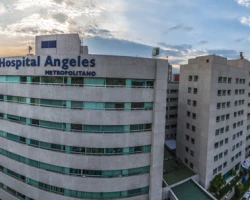
Mexico City, Mexico
Specializations: Cardiac surgery, Vascular surgery, Thoracic surgery, Neurosurgery, Orthopedic surgery, Oncology
1
from Santiago Duran
September 05, 2023
This is the worst hospital experience I've had in my life. I arrived to the emergency room at noon and left at 4 PM whit out being attended to. They charged me $290 USD upon arrival and then made me whit for 2 hours. When they finally call me in, the doctor looked at me 30 seconds and ordered an ultrasonic check that NEVER came. Finally I decided to leave as the lack of attention, the negligence, the lack of information, the complete disregard for my problem and obviously the time spent doing absolutely nothing and listening to the nurses laugh and joke around out side my cubicle, got the best of me. When I decided to leave they made me what another 45 minutes just to return my deposit and give me back my ID which was retained! (Yes the take your official ID and they DON'T give it back until they secure your payment. This is illegal by the way) by the receptionists.
By the way, I came to the ER with an internal bleeding due to a fall. The Traumatology "Dr. Jenny" gave me 30 seconds to look at the huge hematoma I had, and then one hour later another 30 seconds to give me the "self leave paper" to sign. NEVER She gave me any indication or had the intention to help me. In fact she said "there is nothing I can do".
AVOID THIS EMERGENCY ROOM AT ALL COSTS!
1
from Sridhar Bhavani
May 27, 2022
Worst hospitals only into making money I could have got my treatment done cheaper in the USA...they just dump what ever they want for kidney stone laser treatment and stay was a bomb 210000 pesos+80000 for doctors fees...they will empty ur pockets with sweet talks beware doctors are good you could use their services in other hospitals....the taxation department should look into these scamsters
5
from Gabriel Cristian De La Prada
November 09, 2017
Así a surgeon I can strongly recommend this hospital, superb service,and no,j don't work there
Prices for popular procedures:
-
Deep brain stimulation (DBS)
≈ $50,350
-
Brain aneurysm repair
≈ $13,265
-
Brain aneurysm clipping
≈ $13,019
-
Microvascular decompression (MVD)
≈ $9,506
-
Arteriovenous malformation (AVM) resection
≈ $10,341
-
Brain tumors surgery
≈ $8,895
-
Peripheral nerve repair
≈ $4,041
-
Nerve decompression surgery
≈ $3,202
-
Hemicolectomy
≈ $9,736
3.7
5 reviews
1
from Santiago Duran
September 05, 2023
This is the worst hospital experience I've had in my life. I arrived to the emergency room at noon and left at 4 PM whit out being attended to. They charged me $290 USD upon arrival and then made me whit for 2 hours. When they finally call me in, the doctor looked at me 30 seconds and ordered an ultrasonic check that NEVER came. Finally I decided to leave as the lack of attention, the negligence, the lack of information, the complete disregard for my problem and obviously the time spent doing absolutely nothing and listening to the nurses laugh and joke around out side my cubicle, got the best of me. When I decided to leave they made me what another 45 minutes just to return my deposit and give me back my ID which was retained! (Yes the take your official ID and they DON'T give it back until they secure your payment. This is illegal by the way) by the receptionists.
By the way, I came to the ER with an internal bleeding due to a fall. The Traumatology "Dr. Jenny" gave me 30 seconds to look at the huge hematoma I had, and then one hour later another 30 seconds to give me the "self leave paper" to sign. NEVER She gave me any indication or had the intention to help me. In fact she said "there is nothing I can do".
AVOID THIS EMERGENCY ROOM AT ALL COSTS!
1
from Sridhar Bhavani
May 27, 2022
Worst hospitals only into making money I could have got my treatment done cheaper in the USA...they just dump what ever they want for kidney stone laser treatment and stay was a bomb 210000 pesos+80000 for doctors fees...they will empty ur pockets with sweet talks beware doctors are good you could use their services in other hospitals....the taxation department should look into these scamsters
5
from Gabriel Cristian De La Prada
November 09, 2017
Así a surgeon I can strongly recommend this hospital, superb service,and no,j don't work there

Mexico City, Mexico
Specializations: Cardiac surgery, Vascular surgery, Thoracic surgery, Neurosurgery, Orthopedic surgery, Oncology
1
from Gaby Fabián
November 19, 2023
The attention from the nursing staff left much to be desired, it is supposed to be a first-class hospital for such poor service. Omission of analgesics, failure to follow instructions left in writing by the doctor. They ask about food preferences and allergies so they can ignore them. Violation of patients' rights, even though all staff have them attached to their chests on their identification. Not a cheap bill (>200k) for such bad service.
5
from Aketzally López
August 31, 2023
It is a very clean, beautiful hospital, obviously also in the area, the consultations are a little expensive, but they take great care of you. I fully recommend Doctor David Mazza 🫰🏼
5
from Eva Nemeth-Csoka
July 07, 2023
A modern, clean, well-located and very well-equipped hospital. The rooms are spacious, well-organized and the facilities are of excellent quality. Very large parking lot, the signs in the hallways are very clear, but the staff is also very friendly and helpful, they are happy to help you if you can't find something. At the entrance there is a Starbucks Coffee with fresh and tasty food and on the other side a grocery and drinks store. From the entrance there is a very nice view.
Prices for popular procedures:
-
Deep brain stimulation (DBS)
≈ $50,350
-
Brain aneurysm repair
≈ $13,265
-
Brain aneurysm clipping
≈ $13,019
-
Microvascular decompression (MVD)
≈ $9,506
-
Arteriovenous malformation (AVM) resection
≈ $10,341
-
Brain tumors surgery
≈ $8,895
-
Peripheral nerve repair
≈ $4,041
-
Nerve decompression surgery
≈ $3,202
-
Surgical neurolysis
≈ $1,950
3.8
5 reviews
1
from Gaby Fabián
November 19, 2023
The attention from the nursing staff left much to be desired, it is supposed to be a first-class hospital for such poor service. Omission of analgesics, failure to follow instructions left in writing by the doctor. They ask about food preferences and allergies so they can ignore them. Violation of patients' rights, even though all staff have them attached to their chests on their identification. Not a cheap bill (>200k) for such bad service.
5
from Aketzally López
August 31, 2023
It is a very clean, beautiful hospital, obviously also in the area, the consultations are a little expensive, but they take great care of you. I fully recommend Doctor David Mazza 🫰🏼
5
from Eva Nemeth-Csoka
July 07, 2023
A modern, clean, well-located and very well-equipped hospital. The rooms are spacious, well-organized and the facilities are of excellent quality. Very large parking lot, the signs in the hallways are very clear, but the staff is also very friendly and helpful, they are happy to help you if you can't find something. At the entrance there is a Starbucks Coffee with fresh and tasty food and on the other side a grocery and drinks store. From the entrance there is a very nice view.

Puebla, Mexico
Specializations: Cardiac surgery, Vascular surgery, Thoracic surgery, Neurosurgery, Spine surgery, Orthopedic surgery, Oncology
Clinics grouping by rating
Clinic with the highest rating of 3.4 — Galenia Hospital in Cancún, Mexico, clinic with the most reviews number of 284 — Galenia Hospital in Cancún, Mexico.
With rating from 3.0 to 3.9 — 2 clinics.
Countries with the highest number of clinics treating the diseases:
Epilepsy:
worldwide
441 clinics
Brazil
34 clinics
India
33 clinics
Mexico
25 clinics
Germany
24 clinics
Colombia
23 clinics
Related procedures:
Procedures are likely to be used for Epilepsy treatment:
Deep brain stimulation (DBS),
Gamma Knife,
and
Transcranial magnetic stimulation (TMS) - per course
.
Quick navigation
Procedures
Diseases
- Brain shunt surgery ≈ $7,385
- Cholecystectomy ≈ $3,020
- Corpus callosotomy ≈ $5,316
- Craniofacial surgery ≈ $6,319
- Distal gastric resection ≈ $5,434
- Duodenectomy ≈ $2,544
- Elevation of depressed skull fracture ≈ $6,863
- Endoscopic septostomy ≈ $4,524
- Endoscopic third ventriculostomy (ETV) ≈ $4,081
- Esophagogastrectomy ≈ $53,454
- Extended cholecystectomy ≈ $15,219
- Extracranial CSF drainage by request
- Focal resection ≈ $4,189
- Functional hemispherectomy ≈ $7,977
- Gastric endoscopic submucosal dissection (ESD) ≈ $2,388
- Jejunostomy ≈ $3,394
- Laparoscopic cholecystectomy ≈ $1,463
- Laproscopic total gastrectomy ≈ $9,753
- Laser interstitial thermal therapy (LITT) ≈ $17,532
- Lumbar puncture ≈ $562
- Bell's palsy
- Benign bone tumor
- Bone cancer
- Brain metastases
- Cavernous angioma
- Cavernous hemangioma
- Cerebral cavernous malformation (CCM)
- Cerebrospinal fluid leak (CSF)
- Craniofacial injury
- Craniopharyngioma
- Eye cancer
- Eye melanoma
- Glossopharyngeal neuralgia
- Graves' disease
- Head and neck cancer
- Hemifacial spasm
- Hip osteoarthritis
- Hydrocephalus
- Intraventricular tumor
- Knee osteoarthritis
